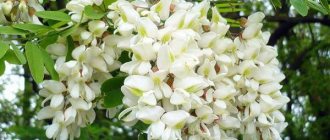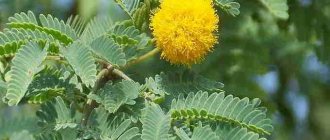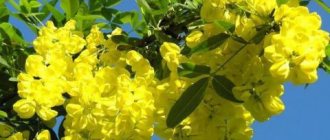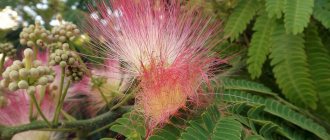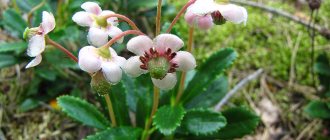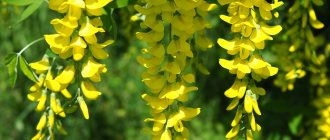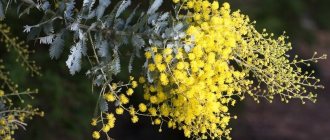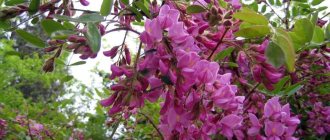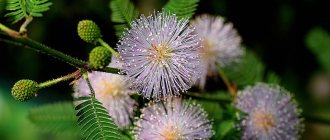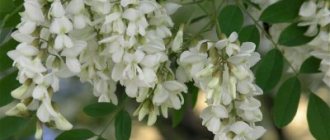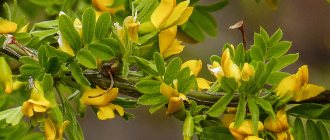Botanical description
Robinia pseudoacacia - false acacia or pseudoacacia came to Europe from North America. Thanks to its high adaptability, it has taken root in all regions with a temperate climate, and has long been perceived in the Old World as a local plant. This is a large tree with a height of 20–25 m and a trunk width of 60–90 cm. The bark of young shoots is gray-brown and smooth. With age it darkens, thickens, interrupted by deep longitudinal cracks . The shoots are densely branched, bare, light olive in color, with small, barely visible buds. The crown is spreading, openwork, rounded at the top, forming several separate wide tiers downwards.
The roots of white acacia have many branches and penetrate several meters deep and wide. At the ends of the shoots there are points sensitive to nitrogen compounds.
The leaves are light, bluish-green, odd-pinnate, consisting of 7–21 elongated lobes, almost sessile on the central petioles. The plates are 3–4 cm long, about 1.5 cm wide, with rounded or notched tops. The back side of the leaves has a matte silver tint.
The flowers are greenish-white or cream-colored, 10–17 mm in size, bell-shaped, collected in drooping racemes 15–20 cm long. In warm regions, the flowering period begins in May, in temperate and continental regions - in June or July.
Fruits: flat, hard beans 5–12 cm long with a brownish-brown skin. Ripen at the end of September. Inside there are from 3 to 15 smooth kidney-shaped seeds, light green or spotted.
Robinia is light-loving, unpretentious to soil composition, and can tolerate prolonged drought. In mixed forests it is adjacent to pine, maple or oak. It grows very quickly, rising in height by 60–90 cm per year. Easily restored by root shoots after cutting down.
What species are acacias confused with?
In the Legume family there are many trees with paired pinnate leaves. In appearance they resemble acacia, but belong to different genera. However, there is still confusion in their names that needs to be sorted out, and the Latin names of plants will help with this.
- white acacia is Robinia pseudoacacia, a large tree with rounded leaves and fragrant white flowers;
- pink acacia, also known as sticky, also belongs to the genus Robinia (Robinia viscosa), is distinguished by mauve flowers and the presence of glands on the stalks and calyxes;
- Lankaran acacia - also known as Japanese, silk, Crimean mimosa and silk tree - belongs to the genus Albizia (Albizia julibrissin), cultivated for its amazingly beautiful pink flowers, collected in fluffy umbrellas, reminiscent of the crests of crowned cranes;
- yellow acacia, also known as tree-like acacia, is actually caragana (Caragana arborescens), a native of Altai and Siberia, the owner of large yellow flowers;
- sand acacia is a plant of the Ammodendron genus, unique for its large, dull purple flowers and ashy calyxes.
An interesting camel's tail acacia grows in Central Asia and Mongolia - in fact, it is called Caragana jubata, or maned cape. The plant looks like a brown, slightly curved column with a tuft of greenery and a rim of white flowers at the top. Similar to our heroine are species of the genus Gleditsia - luxurious, durable trees with powerful red spines and beans up to 40 cm long.
Robinia viscosa
Medicinal properties
The bark, greens and flowers of white acacia are natural medicinal raw materials. They contain glycosides and a number of other chemically active substances:
- tannins;
- alkaloids;
- salicylic acid esters;
- flavonoids;
- phytosterol;
- essential oils;
- tannins;
- ascorbic acid;
- vitamins A and E.
Preparations based on this raw material have a strong choleretic, expectorant, hemostatic, anti-inflammatory, antispasmodic, and antipyretic effect.
The seeds and other parts of black locust contain the poisonous alkaloid robinine . A large amount of it, when ingested, causes severe intoxication, so the tree must be handled with care. Poisoning can occur both when collecting flowers, fruits and bark, and when harvesting wood. Its main symptoms: severe nausea, headache, physical weakness.
Application
Robinia is considered an invasive species because, quickly colonizing new places, it disrupts the natural ecosystem of the region, displacing weaker species and expanding its range. Despite this, there is no attempt to completely exterminate white acacia, given its medicinal and other beneficial properties.
Wood
Robinia wood is classified as a sound species. It has a light greenish-brown or grayish-yellow shiny surface with a contrasting pattern of growth rings and medullary rays. It is a durable, hard material, superior in density to oak and ash. During the drying process it is capricious, but in its finished form it acquires plasticity, biostability and wear resistance. It lends itself well to all types of carpentry, bends, holds any types of fasteners, and is impregnated with varnishes and paints.
White acacia is suitable for external and internal construction work: it is used when installing earthen piles, constructing supports in mines, railway sleepers, temporary bridges, and fences. It is used to make furniture, finishing panels for wall coverings, parquet, ax handles, and handles of agricultural implements.
Traditional medicine and homeopathy
In folk medicine, flowers, bark and young branches of white acacia are used to prepare medicinal decoctions and tinctures for influenza, pneumonia, rheumatic and muscle pain, neuralgia, diseases of the kidneys, bladder, liver, stomach, and intestines. An alcoholic tincture of the bark is used to increase acidity and for hypokinetic cholecystitis.
Externally, an infusion of the bark is used to disinfect cuts, abscesses, abrasions, and heal boils and ulcers.
The alkaloid robinine, which contains parts of the plant, is poisonous in high concentrations . Like many natural toxins, it is in demand in homeopathy and serves as a raw material for the manufacture of multi-directional drugs: for headaches, joint and toothaches, women’s menstrual cycle disorders, colitis, pancreatitis, vegetative-vascular dystonia, neuroses, insomnia, exhaustion.
landscaping
Robinia pseudoacacia is planted along the slopes of ravines, railway embankments, along the edges of abandoned quarries and farmland. Thanks to their powerful branched root system, these trees perfectly strengthen crumbling soils on slopes. Tall spreading crowns create reliable wind protection, preventing soil erosion.
Robinias are good in parks, city squares and gardens . They are decorative and are not afraid of polluted and smoky air. In regions with harsh winters, they rarely grow above 10 m and often branch, forming shrubby forms. In local areas they can be planted singly or created as hedges.
Chemical industry and pharmacology
Yellow and blue pigments are isolated from the bark and leaves of the plant. They are used for the production of dyes and tanning leather.
Fragrant essential oil of flowers is a popular flavoring agent in the pharmacology, perfume and cosmetic industries.
Characteristic
Acacia pycnantha (Acacia pycnantha) is a fairly tall tree belonging to the genus Acacia from the legume family. It got its name from Greek by combining two words: pyknos (dense) and anthos (flowers). And indeed, its inflorescences are very tightly pressed to each other and densely located on the branches.
The height of the trees can be 6-10 meters, some specimens reach 12 meters in height. The root system is quite strong and, like all legumes, has the ability to synthesize nitrogen. Thanks to this, absolutely any type of soil is suitable for the plant. Golden acacia bark can be of various shades, from gray to brown.
Australian acacia flowering
Hanging branches have no leaves. Instead, the Australian acacia has phyllodes - leaf-shaped elongated petioles without a pronounced leaf blade. The bright green petioles are sickle-shaped and can reach 15 cm in length. The tassel-shaped inflorescences are strewn with yellow fluffy spherical flowers.
Acacia begins to bloom in early spring, in March. In the homeland of the plant, in Australia - in September. It is then that nature awakens from its winter sleep on this continent.
Under natural conditions, densely flowered acacia can be found almost everywhere. It grows especially abundantly in the states of Victoria, New South Wales and South Australia, as well as in coastal eucalyptus groves. Outside of Australia, golden acacia can be found in the Mediterranean, southern Europe and the Black Sea coast.
What does acacia look like? The following is a detailed and detailed description of the tree.
Root system
Acacia has a powerful and developed root system.
This is due to the fact that in order to extract water and microelements from the soil, acacia roots have to climb to great depths.
The root system has a main shaft. In the upper layers of the soil it has strong branching; as the depth increases, it decreases.
To keep the roots healthy and functioning well, you need to ensure that the plant is properly watered.
Help: In spring and summer, acacia requires abundant watering; in winter, its frequency should be reduced.
If you water heavily in winter, the roots of the plant will not be able to absorb water normally, which will lead to their rotting.
Trunk and bark
The acacia trunk reaches a height of 25 meters, the average value is 12 meters. It reaches 1.2 meters in diameter.
The surface of the tree trunk has longitudinal grooves.
The color of the bark varies from dark gray to brown. However, in young plants the bark is usually thin and smooth, has a green, light gray or light brown color, and a fissured surface.
Acacia bark has beneficial properties and is used in folk medicine in the form of decoctions to treat gastritis or stomach ulcers (read about the beneficial and medicinal properties of acacia here).
However, you should use acacia bark carefully: it, along with the seeds and roots of the plant, is extremely poisonous.
In case of overdose, swelling, cramps, poisoning, headache, diarrhea, drowsiness, and malaise are possible.
If poisoning occurs with acacia bark, seeds or roots, you should do a gastric lavage, take activated charcoal and call an ambulance.
Leaves
Acacia leaves are ovoid in shape. The upper side of the leaf plate is smooth, has a green color, the lower side has a velvety structure and a grayish-green tint. What is the leaf arrangement of acacia? The leaf arrangement of acacia is alternate: the leaves are located opposite on the petioles, in quantities from 7 to 21 pieces. They have a paired-pinnately complex structure.
Double dissected, they consist of leaf-shaped formations that are equipped with glands.
Sometimes the leaves are completely replaced by needle-shaped or ovoid overgrown cuttings.
The periophytes are small and leathery. In some cases, needles may be replaced or absent.
Acacia flowers are white or yellow in color and have a pleasant smell; they are collected in hanging clusters.
Also, acacia flowers can be:
- small and numerous;
- large and single;
- in inflorescences of a capitate type;
- in cylindrical brushes;
- in panicle-type inflorescences;
- in leaf axils;
- at the ends of branches;
- heterosexual;
- bisexual.
In heterosexual flowers, the number of flowers with stamens prevails over the number of flowers with pistils. Acacia stamens are numerous, their number exceeds 50 in one flower.
They always protrude above the rim. Colored orange, yellow or cream. The acacia pistil is thread-like.
The acacia fruit is a flat pod, brown in color and has 5-6 seeds. The seeds are an elongated bean. He can be:
- ovoid;
- linear;
- lanceolate.
Usually the bob is straight, but beans that are curved at different angles are often found. It may have pubescence on the surface or be smooth.
Its structure can be leathery or wooden. Acacia fruits have healing properties. It contains various esters and sugars.
Decoctions of acacia fruits help cope with bronchitis and pneumonia; compresses from such decoctions help heal cuts and wounds.
The main rule is to avoid overdose, as the plant is very poisonous.
We suggest you familiarize yourself with How to grow porcini mushrooms in the country
Thus, acacia is a plant of extraordinary beauty. It has a complex structure.
White acacia honey
Robinia is a valuable honey plant. During the flowering period, fragrant brushes attract bees from all over the area. One large mature tree can produce up to 15 kg of nectar per season.
Acacia honey is considered healthier than other types . It contains less organic acids and pollen, so it is approved for use by people with high stomach acidity and those who are prone to allergies. This honey is superior to other varieties in its antimicrobial and anti-inflammatory qualities.
Another important feature is that it remains liquid for a long time . While other species crystallize 2–3 months after harvest, acacia remains transparent for almost two years. The proportions of sugars in it are different: fructose predominates almost 1.5 times over glucose. This allows the product to be used for cosmetic and medical procedures in which heating is unacceptable and a liquid substance is required.
Robinia honey tastes delicate, with a subtle floral aroma and a bitter aftertaste.
Landing
To place Robinia, it is necessary to choose flat or elevated, well-lit areas with a low groundwater level. The fertility of the soil is not of great importance; what is more important is its looseness and alkaline reaction. This plant is not afraid of saline soils. It is recommended to add lime, dolomite flour, and wood ash to acidic ones. Heavy soils - dilute with sand.
When choosing places for planting, you need to retreat away from the walls of buildings, fruit trees and vegetable beds. Over time, the acacia roots will grow in width and drown out all the others. The presence of communications: cables, pipelines is a big obstacle for Robinia.
It is advisable to carry out the work in early May . Plantings that are planted too early or in the fall may suffer from severe cold. The soil around the future seedling is dug up, removing the grass. A pit is prepared with a depth and width twice the volume of its roots. If the soil is not loose enough, a thick layer of stone drainage is laid on the bottom. When planting a tree, the root collar is not buried. At the end of the work, a bucket of water is poured under the trunk. It is recommended to mulch the adjacent soil with a 7–8 cm layer of high-moor peat.
Yellow acacia: description, planting and care
It grows very quickly. The annual growth reaches 50 cm in height and up to 30 cm in width. Yellow flowers are collected in clusters of 3-5 pieces. The foliage is green in spring and summer and bright yellow in autumn. The fruits are pods up to 5 cm long. It blooms from May to June.
Japanese quince shrub - description of the plant and fruits
Frost- and drought-resistant bushes can be planted in most of Russia: in the Urals, Western Siberia, the Far East, the Sayan Mountains, and Altai. It needs care in the first years of life: watering, fertilizing, and crown formation are important. In the future it can grow without any human intervention. It is undemanding to the soil, but does not tolerate high groundwater levels. Planted in a permanent place in spring or autumn.
Use in landscape design
Not the most beautiful of existing crops, this shrub is very much loved by gardeners for its unpretentiousness and vitality, beautiful fragrant flowering. It is planted in those corners of the garden where other plants cannot withstand drought, and the result - a lush bush - is guaranteed. Strong winds, scorching heat, and saline soil are of no concern to Karagan.
For your information! Bushes are often used to create hedges. They will serve as an excellent and reliable shelter for more delicate plants.
Can be planted by seeds and cuttings. The survival rate is excellent, it does well in multi-row plantings. The effect on the soil is most positive: it enriches it with nitrogen and prevents erosion.
Care instructions
Robinias are not capricious and resistant to adverse weather conditions, so they do not cause any trouble taking care of themselves.
Plants need to be watered only in the first two seasons and only during drought . Mature trees develop powerful roots and extract moisture from the soil. Excess water will damage them, causing them to rot.
There is no need to feed white acacia . It itself enriches the soil with nitrogenous compounds, and for rapid growth it transforms substances found in the soil. Trees begin to bloom 3–4 years after planting. If the formation of inflorescences is delayed or they are very rare, it is recommended to apply potassium fertilizers to the soil in the spring. They can be scattered dry around the trunk, and then lightly moisten the soil. Weeds under the trunks should be removed. There should be no turf above the roots of Robinia.
For the winter, young seedlings need to be insulated . The roots are covered with a thick layer of peat or leaves, and the crowns are wrapped in thin burlap in severe frosts. Frosted branches in the spring can be pruned short without regret - this stimulates further growth of the trees. After 4–5 years, the frost resistance of acacia improves, and it is no longer necessary to cover it.
Shaping haircut is encouraged. Shoots can be shortened to half their length. This must be done in March or April, before flowering begins.
Distribution and ecology [ edit | edit code ]
Widely distributed in tropical and subtropical regions of both hemispheres - between 35° north latitude and 42° south latitude.
They grow in various environmental conditions - in dry deserts (Mexico, Australia), in humid areas (India, Madagascar), usually in low-lying parts, in river valleys on alluvial and rocky soils containing a minimal amount of lime; climb mountains up to 1000 m above sea level. They often form pure stands.
Acacias are among the fastest growing species; in the first year of life they reach a height of 0.75–1.5 m; on the second - 2-2.5 m, on the third - up to 4-5 m with a trunk diameter of 3-4 cm at a height of 1 m; at the age of 12-15 years - 15-18 m. Intensive growth of trees stops by 25-30 years; plants at the age of 30 years are already aging, their crown is thinning out, the bark is cracking and hollowness appears.
Most species form abundant growth from the root collar and produce abundant root shoots already from the second or third year of life. Flowering occurs from the first or more often from the second year of life, and then, like fruiting, occurs regularly every year.
Propagated by sowing seeds. Sowing is done directly into the soil, 3-5 seeds are placed in each hole. After the emergence of seedlings, the plants are thinned out.
Read also: How to prune raspberries after planting in the fall
Pests [edit | edit code]
They damage leaves, young shoots, branches, and trunks. To combat them, the following measures are used:
- biological (use of cryptolemus and rhodolia or novius against scale insects),
- mechanical (regular destruction of scale insects and their eggs, collection of caterpillars),
- chemical (fumigation of plants with hydrocyanic acid).
Reproduction
White acacia can be propagated by seeds, layering or root suckers. In the first case, the material is first scarified by cutting the dense shell and embedded in the soil to a depth of 2–3 cm. The sprouts appear after 10–15 days and in the first season reach a height of 60–80 cm.
The offspring, growing up to 40–50 cm, are carefully dug up in the summer and simply transferred to new places.
Varietal specimens can be propagated by air layering, bending strong long branches to the ground. At the point of contact with the soil, notches are made on them and dug in. During the warm season, the cuttings take root; the next year they are cut off and replanted.
Recipes
The simplest recipe for using Robinia:
- Flower tea. Take 1 tbsp. a spoonful of raw materials, crushed and brewed with a glass of boiling water. Add milk and honey to the finished drink, drink a glass half an hour before meals for colds.
- For a long, incessant cough, a decoction of Robinia flowers mixed with wheatgrass root is recommended. The raw materials are crushed, brewed with a glass of boiling water and infused for an hour, then filtered and taken a third of a glass before each meal. If the infusion is replaced by simmering in a water bath for 20 minutes, an infusion is obtained for the treatment of inflammatory diseases of the genitourinary system.
- Aching joints are treated with tincture, which is prepared from 50 g of dried flowers and 400 ml of high-quality vodka. The mixture is infused for 3 weeks, after which it is rubbed on the skin in the joint area several times a day.
Acacia flower tea is taken for colds
There has never been such botanical confusion with any plant as with acacia. But various types of acacias, Robinia and Albizia continue to raise their lush crowns to the sky, decorate gardens and parks with magnificent leaves and inflorescences, and supply folk healers with excellent medicinal raw materials.
We invite you to familiarize yourself with Beautiful Chernobrivtsy: distinctive features and healing properties
Diseases and pests
If the trees' moisture regime is organized correctly, they are not threatened by disease. This is facilitated by the presence of toxic compounds in greens and bark that inhibit the activity of microbes.
Among the parasites of white acacia, the false scale insect and the sawfly are threatened . They suck the juices from young greenery. To protect crowns from pests, it is useful to regularly treat them with infusions of hemlock, black henbane, and soda solution. In case of massive lesions, insecticides are more effective: Karbofos, Aktera and others.
In favorable conditions with proper care, robins live up to 100 years, and if there is a threat of death, plants are easily restored from seeds or by vegetative methods.
